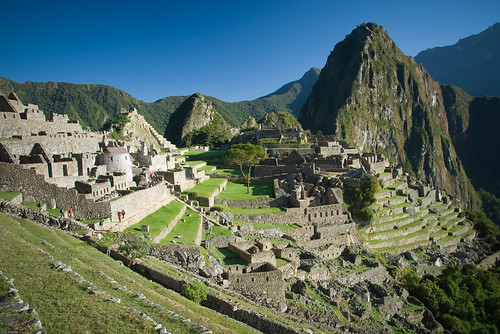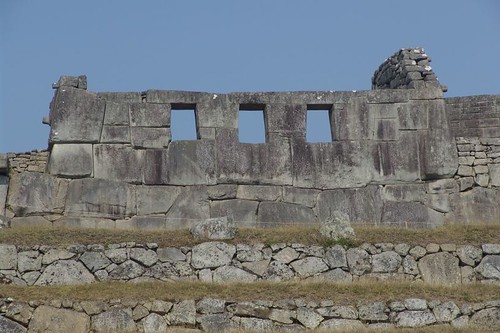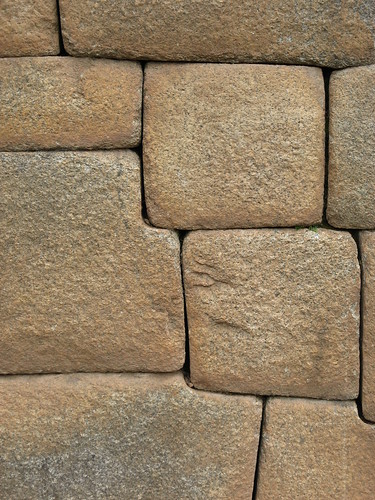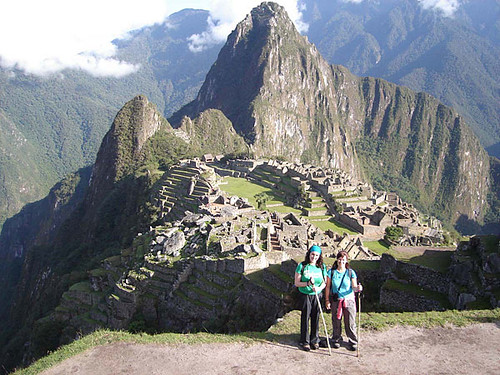 Machu Picchu (Quechua: Machu Pikchu "Old Peak") is a pre-Columbian Inca city located at 2,430 m (7,970 ft) altitude on a mountain ridge above the Urubamba Valley in Peru, about 70 km (44 mi) northwest of Cusco. Forgotten for centuries by the outside world, although not by locals, it was brought back to international attention by archaeologist Hiram Bingham in 1911, who made the first scientific confirmation of the site and wrote a best-selling work about it. Machu Picchu is probably the most familiar symbol of the Inca Empire. It is often referred to as "The Lost City of the Incas". The site was designated as a World Heritage Site in 1983 when it was described as "an absolute masterpiece of architecture and a unique testimony to the Inca civilization".
Machu Picchu (Quechua: Machu Pikchu "Old Peak") is a pre-Columbian Inca city located at 2,430 m (7,970 ft) altitude on a mountain ridge above the Urubamba Valley in Peru, about 70 km (44 mi) northwest of Cusco. Forgotten for centuries by the outside world, although not by locals, it was brought back to international attention by archaeologist Hiram Bingham in 1911, who made the first scientific confirmation of the site and wrote a best-selling work about it. Machu Picchu is probably the most familiar symbol of the Inca Empire. It is often referred to as "The Lost City of the Incas". The site was designated as a World Heritage Site in 1983 when it was described as "an absolute masterpiece of architecture and a unique testimony to the Inca civilization".History
 Machu Picchu was built around 1450, at the height of the Inca empire, and was abandoned less than 100 years later, when the empire collapsed in the Spanish conquest. Although the Citadel is located only about 50 kilometres from Cusco, the Inca capital, it was never found and destroyed by the Spanish, like many other Inca sites. Over the centuries, the surrounding jungle grew on the site wrap, and few knew of its existence. In 1911, Yale historian Hiram Bingham and researchers, the "lost" city in the world attention. Bingham and others suspected that the citadel was the traditional birthplace of the Inca people or the spiritual centre of the "virgins of the sun", while the curators of the exhibition have recently speculated that Machu Picchu was a royal retreat.
Machu Picchu was built around 1450, at the height of the Inca empire, and was abandoned less than 100 years later, when the empire collapsed in the Spanish conquest. Although the Citadel is located only about 50 kilometres from Cusco, the Inca capital, it was never found and destroyed by the Spanish, like many other Inca sites. Over the centuries, the surrounding jungle grew on the site wrap, and few knew of its existence. In 1911, Yale historian Hiram Bingham and researchers, the "lost" city in the world attention. Bingham and others suspected that the citadel was the traditional birthplace of the Inca people or the spiritual centre of the "virgins of the sun", while the curators of the exhibition have recently speculated that Machu Picchu was a royal retreat.It is thought that the site was chosen for its unique location and geological features. It is said that the silhouette of the mountain range behind Machu Picchu represents the face of the Inca looking upward towards the sky, with the largest peak, Huayna Picchu (meaning Young Peak), representing his pierced nose.
In 1913, the site received significant publicity after the National Geographic Society devoted their entire April issue to Machu Picchu.
On July 7, 2007, Machu Picchu was voted as one of New Open World Corporation's New Seven Wonders of the World.
Location
 Machu Picchu is 70 km northwest of Cusco, at the summit of the mountain of Machu Picchu, is located about 2350 meters above sea level. It is one of the most important archaeological sites in South America and the most visited tourist attraction in Peru. From the top, on the cliff of Machu Picchu, is a vertical precipice of 600 metres, ending at the foot of the Urubamba River. The situation of the city was a military secret, because its deep gorges and mountains were an excellent natural defenses.
Machu Picchu is 70 km northwest of Cusco, at the summit of the mountain of Machu Picchu, is located about 2350 meters above sea level. It is one of the most important archaeological sites in South America and the most visited tourist attraction in Peru. From the top, on the cliff of Machu Picchu, is a vertical precipice of 600 metres, ending at the foot of the Urubamba River. The situation of the city was a military secret, because its deep gorges and mountains were an excellent natural defenses.Architecture
 All of the construction in Machu Picchu uses the classic Inca architectural style of polished dry-stone walls of regular shape. The Incas were masters of this technique, called ashlar, in which blocks of stone are cut to fit together tightly without mortar. Many junctions in the central city are so perfect that not even a knife fits between the stones.
All of the construction in Machu Picchu uses the classic Inca architectural style of polished dry-stone walls of regular shape. The Incas were masters of this technique, called ashlar, in which blocks of stone are cut to fit together tightly without mortar. Many junctions in the central city are so perfect that not even a knife fits between the stones.The Incas never used the wheel in any practical manner. How they moved and placed enormous blocks of stones is a mystery, although the general belief is that they used hundreds of men to push the stones up inclined planes. It is unknown if the Incas left behind any documentation about that process; if there is narrative information in the record keeping system they employed, called khipus, which is currently not readable.
The space is composed of 140 constructions including temples, sanctuaries, parks and residences, houses with thatched roofs.
There are more than a hundred flights of stone steps - often completely carved in a single block of granite - and a large number of wells, through channels with each other water and drainage facilities drilled in the rock, for the original irrigation system. Evidence has been found that the irrigation system was used to carry water from a sacred source that each of the houses in turn, the order is determined by the perception of the sanctity of the residents.
Visiting Machu Picchu
 All visits to Machu Picchu at some point leave from Cusco, which can be reached via a domestic flight from Lima. Taking the tourist train from Cusco (which takes 3.5 hours to get to Machu Picchu), you have several options.
All visits to Machu Picchu at some point leave from Cusco, which can be reached via a domestic flight from Lima. Taking the tourist train from Cusco (which takes 3.5 hours to get to Machu Picchu), you have several options.The most common way is to take the train to Machu Picchu in the morning, explore the ruins for a few hours and return to Cusco in the afternoon. The train terminates at Puente Ruinas station, where buses take tourists up the mountain to Machu Picchu. Strangely, Machu Picchu station is at Aguas Calientes (2 km before Puente Ruinas station) but is not the station used by tourists on a day trip.
Another option is to hike the Inca Trail, on either a four-day or two-day version, both of which are controlled by the government. They require travelers to be reasonably fit. The trip takes a few days, and involves sleeping in tents.
Another option is to stay overnight near the ruins themselves, rather than return on the same day. There are many hotels at nearby Aguas Calientes , but only one hotel at Machu Picchu itself. Buses run from Aguas Calientes to the ruins throughout the day, an 8 km ride up the mountain (approximately one and a half hours by walking).
A helicopter service from Cusco to Aguas Calientes, via a 24 passenger Russian Mi-8 helicopter, is also available. Helicopter flights direct into Machu Picchu stopped in the 1970s due to concern about their damage to the ruins.
Related video's from Metacafe
Machu Picchu, Lost City Of The Incas
Machu Picchu excerpt from "The Inca Lost and Found", the Intrepid Berkeley Explorer's video of Peru. Never found by the Spanish, Machu Picchu was discovered by accident ... More»centuries later. It is the most intact and famous Inca Empire site, whose purpose remains unknown to this day.
Machu Picchu is high in the Andes Mountains of Peru, and Peru is one of South Americas most magnificent and authentic countries. Machu Picchu was once a royal palace buil... More»t by an Incan ruler. Machu Picchu sits like a mysterious city eight thousand feet above the sea. Perus most famous site, Machu Picchu, is more than Perus. Machu Picchu is one of the wonders of the world with its two hundred buildings and cloud covered beauty. About twelve hundred people lived in Machu Picchu, and Peru has done an exceptional job of preserving Machu Picchu. Professional Inca architects built Machu Picchu with granite blocks and bronze tools. The Inca architects at Machu Picchu were so advanced that the thinnest of knife blades can not be forced between the stones. Travelers to Peru, to Machu Picchu climb the steep Inca trail to Machu Picchu. But there is a tourist bus from the town. Arrive at Machu Picchu before dawn and do not be disappointed by the fog. The ruins and the surrounding mountain peaks show how the fog lifts, and steal your breath away. Machu Picchu is an authentic travel experience, if you climb Machu Picchu in Peru on foot, do not forget if you are on the ground, your legs will thank you for the next morning. Machu Picchu is an authentic travel experience. Peru's Machu Picchu was discovered ninteen eleven.